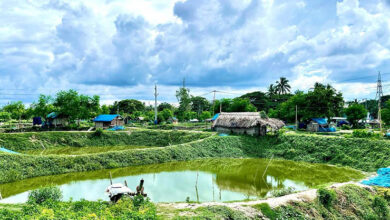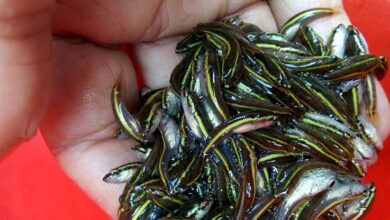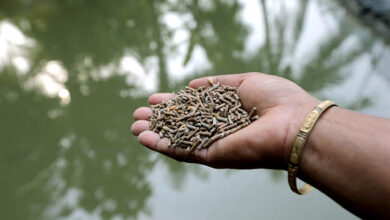In general, an ideal aquaponics system will assist you in making money by selling its products to buyers at markets or directly to local food stores. Aside from selling fish and crops, some aquaponics farms make money by selling aquaponics systems and teaching aquaponics classes to interested parties. Knowing your aim is essential for a successful aquaponics operation. If you are new to aquaponics, consider hiring an aquaponics specialist as a resource to teach you how to run an aquaponics farm business.
How to Start a Commercial Aquaponics System:
Here are the measures you must take before beginning your own aquaponics system.
- Learn how it works and how to operate an aquaponics system if you are a newbie. If you are new to aquaponics, it is best to start with a modest system to understand the ins and outs of the system.
- Choose a location for your aquaponics system. Choose a spot that will provide enough sunshine for your plant.
- Choose and create the aquaponics system you want to use.
- Gather all of the necessary materials and begin assembling your system.
- To learn more about managing and maintaining your aquaponics, you should continue to speak with other aquaponics farmers or entrepreneurs.
Design: Key Features and Components:
A well-designed aquaponics system can help you maximize productivity, save expenses, and assure the system’s lifespan. One of the most apparent aspects of the aquaponic system is the enormous number of different ways it may be built. The size and kind of each component should also be examined to match the specific objectives and goals of your. Despite this variation, any aquaponics setup must include five main components: a rearing tank, solids removal, a bio filter, a hydroponics subsystem, and a sump. These critical components all perform the following functions: fish and plant production, suspended solids removal, and bacterial nitrification.
1. Fish tank:
The fish tank is where the fish are reared and their excrement is transformed into plant fertilizers. The size and number of fish that will be raised should determine the size of the fish tank. One fish need approximately 10 liters (2.5 gallons) of room. Therefore, with a 50 gallon fish tank, you can keep 20 fish. The more water you have, though, the better the system will be stabilized.
2. Grow bed:
The grow bed is where the plants are grown. Depending on your media-based system, it is filled with grow media such as expanded clay or gravel, PVC pipes, floating rafts, or any food-grade containers. To offer nutrients to the plants, water is cycled through the grow bed. A frame is required to sustain the weight of your grow bed. Depending on your system, you may need to add nutrients to the water. Iron, calcium, magnesium, potassium, and boron are all minerals. These can be fed to the water in chelated form every three weeks or so, as in supplementing aquaponics with vermiculture.
3. Bacterial Population
The elimination of ammonia, which is excreted as a metabolic waste product from the gills of fish, is a critical component of the aquaponics system. The fish will perish if the ammonia content is too high. The bacteria colony that inhabits the entire system is in charge of converting nitrites and ammonia to nitrates, which the plants can then use. Without this conversion, nitrites and, to a lesser extent, ammonia would accumulate to dangerous levels, killing fish and vegetation. To speed up the colonization process, extremely small volumes of urea fertilizer can be introduced as an ammonia source.
4. Water pump:
A water pump is required for effective water circulation. It is in charge of moving water from the fish tank to the grow bed and back. The size of the water pump is determined by the intended tank exchange rate and the number of grow beds.
5. Filtration:
A water filter is a device that filters solid waste and dirt from water. A biofilter is an example of a filter in an aquaponics system.
6. Aeration system:
An aeration system allows fish and plants to breathe. It is possible to achieve this by employing air stones, diffusers, or pumps. These are utilized in the fish tank as well as the media beds.
7. Lighting system:
A lighting system is utilized to provide lighting to the plants. Because indoor aquaponics systems do not have access to sunshine, lighting is only necessary. You don’t need growl lights if you have an outside system.
8. Backup power source:
In aquaponics systems where the electrical source is unstable, a backup power source such as generators, battery backup systems, or solar power is necessary.
9. Sump Tank:
The use of a sump tank will be determined by the architecture of your system.
10. Bell siphoning:
A bell siphon is required for a flood and drains the media bed.
11. Heater:
The use of a water heater will be determined by your location, fish species, and desired water temperature.
12. Monitoring System:
How you manage, your system relies on your situation. Timers and controllers control all lighting, pumps, and temperature.
Tips on How to Make Your Aquaponics More Profitable:
If you wish to expand your tiny aquaponics system to a larger scale, such as a farm, for commercial purposes. Then, here are including below some suggestions for increasing the profitability of your aquaponics business.
- Knowing your goal is essential for running a successful commercial aquaponics operation. If you are new to aquaponics, consider hiring an aquaponics specialist as a resource to teach you how to run an aquaponics farm business.
- Determine and comprehend what will work best for you. Because there is an investment involved, you cannot simply experiment with various things that may impact your system. Making the proper decisions is essential to running a successful aquaponics business.
- Do not get too large too soon. Before expanding into a huge aquaponics firm, it is preferable to start small and become an expert. Sell a wide range of products. You can reach a larger market by selling a variety of products.
- The simplest method to increase profits is to sell only high-quality products.
- The Aquaponics business is not easy, so you must devote time to become an expert so that you do not have to rely on others to operate your firm.
- You can reach a larger market by selling a variety of products.
Many businesses have begun to create the commercial aquaponics farming industry of mass production of fish and crops nowadays. Most aquaponics systems nowadays are housed in controlled conditions, such as greenhouses or outdoor sites with ideal climates. Many spotted the aquaponics industry’s promise, and it is likely to grow further.
Farhana Islam
Agriculturist, Researcher
Fisheries Resource Management, CVASU





